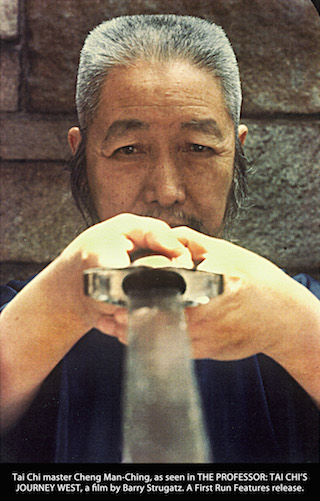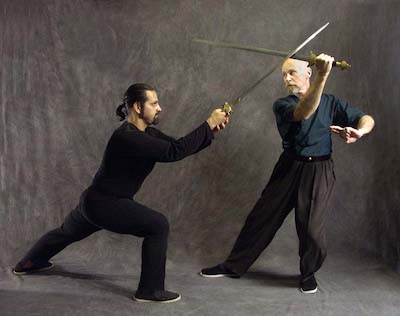Transcendence – SOME THOUGHTS

- The Chinese double-edged sword (Jian) can be an instrument of transcendence. According to the Tarot the sword represents action and process, it separates and discerns, it passes barriers.
- Fencing presents new opportunities and new challenges. There is a great deal of charge in a sword and one cannot ignore the fact that it is a weapon. Some people have difficulty taming this charge and are not able to relax with the sword. They will require patience.
- We may think of the sword as a ruler that measures your ability to be relaxed, to extend your chi, and to fine-tune your sensitivity.
- Using a sword in the Tai Chi way will enhance your relationship with any instrument, be it a shovel, a brush, or a violin.
- Accuracy comes from doing the form and fencing with consistency in mind.
- Rhythm comes from practising with evenness of movement, simultaneity of action, and balance of Yin and Yang.
- Stick to the O’s blade, but do not get stuck on it.
- Know the O’s blade, but don’t try to control it.
- The occasional use of a heavy sword will help you to move the sword on its energy lines, since moving it otherwise requires so much more effort.
- Practice “Single Whip” footwork; it is useful for tight circling while fencing.
- If you do not know an application for a move you will not understand the energy of the move.
- The bowstring is Yin, soft and supple, yet when strung it connects and takes on the strength of the bow, becoming Yang. Similarly, our arms connect to our centre and acquire its strength.
- A whip is Yin, soft and supple even as it is being wielded. Only, at the point that it achieves its energy alignment, (straightens out) does it become completely Yang and as hard as steel.
Author and Images: Ken van Sickle
German version on our sister site!
- ON BEING A MASTER – Tai Chi Sword 53
- STRANGERS – Tai Chi Sword 52
- PADDED SWORDS – Tai Chi Sword 51
- SAFETY – Tai Chi Sword 50
- PARALLELS – Tai Chi Sword 49
- Swordsmanship – SEVEN QUOTES – Tai Chi Sword 48
- TI FENG & FA JING – Tai Chi Sword 47
- SUPPOSITIONS – Tai Chi Sword 46
- LAO TZU (Laozi) QUOTES – Tai Chi Sword 45
- ETIQUETTE – Tai Chi Sword 44
- FENCING PROCESS – Tai Chi Sword 43
- STRATEGIES – Tai Chi Sword 42
- TASSELS IN THE WIND – Tai Chi Sword 41
- SHOOT FLYING GOOSE – Tai Chi Sword 40
- RHINOCEROS GAZES AT MOON – Tai Chi Sword 39
- THE MASTER SITS BACK – Tai Chi Sword 38
- FIVE APPLICATIONS – 1. BLOCK AND SWEEP – Tai Chi Sword 37
- RULES OF ENGAGEMENT – Tai Chi Sword 36
- CONSIDER – Tai Chi Sword 35
- INVITATIONS – Tai Chi Sword 34
- THE TASSEL – Tai Chi Sword 33
- THE SWORD FINGERS – Tai Chi Sword 32
- Cheng Man Ching Photographs
- THE JOINTS – Tai Chi Sword 31
- THE GRIP – Tai Chi Sword 30
- SWORD MOVEMENT – Tai Chi Sword 29
- ON ALIGNMENT – Tai Chi Sword 28
- CONCERNING THE CENTRE – Tai Chi Sword 27
- EQUATIONS – Tai Chi Sword 26
- HSIN AND CHI – Tai Chi Sword 25
- On studying – NINE QUOTES – Tai Chi Sword 24
- THE SWORD MAIDENS – Tai Chi Sword 23
- THE SWORD AND CALLIGRAPHY – Tai Chi Sword 22
- Returning – MORE THOUGHTS – Tai Chi Sword 21
- Levels of TAI CHI SWORD – Tai Chi Sword 20
- FENCING – Tai Chi Sword 19
- Transcendence – Tai Chi Sword 18
- TURNING TRICKS – Tai Chi Sword 17
- Names of CHENG MAN CH’ING’S TAI CHI SWORD – Tai Chi Sword 16
- FORCE – Tai Chi Sword 15
- DIFFERENCES – Tai Chi Sword 14
- BEGINNERS’ MISTAKES – Tai Chi Sword 13
- MIND SETS – Tai Chi Sword 12
- SENSITIVITY – Tai Chi Sword 11
- HARMONY – Tai Chi Sword 10
- TIME AND HUMOUR – Tai Chi Sword 9
- WHY AND HOW – Tai Chi Sword 8
- SWORD DIMENSIONS – Tai Chi Sword 7
- A ROYALTY OF ARMS – Tai Chi Sword 6
- KENNETH VAN SICKLE – Tai Chi Sword 4
- CHENG MAN CH’ING – Tai Chi Sword 5
- PREFACE – Tai Chi Sword 3
- Introductory Thoughts – Tai Chi Sword 2
- EDITOR’S PREFACE -Tai Chi Sword 1
- Tai Chi Sword by Kenneth van Sickle




